Infernodrakon (meaning "dragon from hell") is an extinct genus of azhdarchid pterosaurs from the Late Cretaceous Hell Creek Formation of Montana, United States. The genus contains a single species, I. hastacollis, known from a single neck vertebra. Based on comparisons with related azhdarchids, it probably had a wingspan of about 4.15 m (13.6 ft).
History of discovery
In 2002, a putative immature Tyrannosaurus specimen (BMR P2002.4.1, known as "Jane") was recovered from strata belonging to the Maastrichtian-age Hell Creek Formation in Carter County, Montana, United States. Alongside that specimen was the fifth cervical (neck) vertebra of an azhdarchid pterosaur. Catalogued as BMR P2002.2, it was originally assigned to cf. Quetzalcoatlus sp.[1] In 2014, Alexander Averianov identified the specimen as indeterminate azhdarchid.[2] In 2021, Brian Andres and Wann Langston Jr. classified BMR P2002.2 more broadly as an indeterminate azhdarchiform.[3]
In 2025, a team consisting of Henry Thomas, David W. E. Hone, Timothy Gomes, and Joseph E. Peterson re-examined the specimen, determining that it belonged to a novel genus more closely related to Arambourgiania philadelphiae from Jordan than to Quetzalcoatlus. The authors designated BMR P2002.2 as the holotype of a new pterosaur genus and species, Infernodrakon hastacollis.[4]
The generic name, Infernodrakon, combines the Italian word inferno (derived from the Latin infernus), meaning "hell", after the discovery of the holotype in the Hell Creek Formation, with the Ancient Greek δράκων (drakon), meaning "dragon". The specific name, hastacollis, combines "hasta"—a type of Roman spear—with the Latin root collum, meaning "neck", referencing the extremely long and thin morphology of the preserved vertebra. This name also references the specific epithet of the related Azhdarcho lancicollis, which is derived from the Roman lancea javelin. The intended full binomial name meaning is "spear-necked dragon from Hell".[4]
Description
Infernodrakon is known only from a single neck vertebra measuring 35 cm (14 in) long. This bone is extremely elongated and gracile; the ratio of the preserved length to the width at the middle of the centrum ('elongation ratio') is 15.1. The only comparable ratios in azhdarchids are found in quetzalcoatlines, such as 16.3 in Quetzalcoatlus lawsoni. All other azhdarchids for which this ratio can be determined demonstrate ratios below 6. Based on comparisons with related taxa, the maximum straight-line wingspan of Infernodrakon was likely close to 4.15 m (13.6 ft). Considering the natural curvature of the wing, the wingspan would have been shorter, at around 3–4 m (9.8–13.1 ft). As such, it is comparable in size to Quetzalcoatlus lawsoni (4.8 m (16 ft)) and Zhejiangopterus.[4]
The other feature that distinguishes Infernodrakon from all other known azhdarchids is the presence of accessory pneumatic foramen (air hole) dorsal to the opening of the posterior neural canal (the back wall of the spinal canal). In all other azhdarchids, the pneumatic foramen is dorsal or lateral to the opening of the anterior neural canal (the front wall of the spinal canal), or to both the anterior and posterior neural canal opening. Additionally, the size of the anterior neural canal opening in Infernodrakon is significantly larger than in other azhdarchids.[4]
Classification
To assess the relationships of Infernodrakon, Thomas et al. (2025) scored it in the comprehensive pterosaur-focused phylogenetic matrix of Pêgas, 2024.[5] They recovered Infernodrakon as the sister taxon to Arambourgiania within the azhdarchid clade Quetzalcoatlinae. These results are displayed in the cladogram below:[4]
| Azhdarchomorpha |
| ||||||||||||||||||||||||||||||||||||||||||||||||||||||||||||||||||||||||||||||
Palaeoecology
Though azhdarchid lifestyles have long been debated, more recent analyses suggest that they hunted small terrestrial prey. This model is known as the 'terrestrial stalking' hypothesis.[7][8] Prey size in azhdarchids would have been limited primarily by torso size, the morphology (and accordingly strength) of their cervical vertebrae, and skull width.[4][9] Infernodrakon, being a mid-sized azhdarchid with gracile neck vertebrae, would have likely been poorly adapted to the stresses of handling or swallowing large animals. As such, it can be identified as a mesopredator, likely consuming small animals including juvenile archosaurs, squamates (lizards and snakes), mammals, amphibians, and eggs.[4]
References
- ^ Henderson, Michael D.; Peterson, Joseph E. (2006). "An azhdarchid pterosaur cervical vertebra from the Hell Creek Formation (Maastrichtian) of southeastern Montana" (PDF). Journal of Vertebrate Paleontology. 26 (1): 192–195. doi:10.1671/0272-4634(2006)26[192:AAPCVF]2.0.CO;2. S2CID 130751879.
- ^ Averianov, Alexander (2014-08-11). "Review of taxonomy, geographic distribution, and paleoenvironments of Azhdarchidae (Pterosauria)". ZooKeys (432): 1–107. Bibcode:2014ZooK..432....1A. doi:10.3897/zookeys.432.7913. ISSN 1313-2970. PMC 4141157. PMID 25152671.
- ^ Andres, B.; Langston, W. Jr. (2021). "Morphology and taxonomy of Quetzalcoatlus Lawson 1975 (Pterodactyloidea: Azhdarchoidea)". Journal of Vertebrate Paleontology. 41 (sup1): 46–202. Bibcode:2021JVPal..41S..46A. doi:10.1080/02724634.2021.1907587. ISSN 0272-4634. S2CID 245125409.
- ^ a b c d e f g Thomas, Henry N.; Hone, David W. E.; Gomes, Timothy; Peterson, Joseph E. (2025-02-28). "Infernodrakon hastacollis gen. et sp. nov., a new azhdarchid pterosaur from the Hell Creek Formation of Montana, and the pterosaur diversity of Maastrichtian North America". Journal of Vertebrate Paleontology: e2442476. doi:10.1080/02724634.2024.2442476. ISSN 0272-4634.
- ^ Pêgas, Rodrigo V. (2024-06-10). "A taxonomic note on the tapejarid pterosaurs from the Pterosaur Graveyard site (Caiuá Group, ?Early Cretaceous of Southern Brazil): evidence for the presence of two species". Historical Biology: 1–22. doi:10.1080/08912963.2024.2355664. ISSN 0891-2963.
- ^ Longrich, Nicholas R.; Martill, David M.; Andres, Brian (2018-03-13). Penny, David (ed.). "Late Maastrichtian pterosaurs from North Africa and mass extinction of Pterosauria at the Cretaceous-Paleogene boundary". PLOS Biology. 16 (3): e2001663. doi:10.1371/journal.pbio.2001663. ISSN 1545-7885. PMC 5849296. PMID 29534059.
- ^ Witton, Mark P.; Naish, Darren (2008). "A Reappraisal of azhdarchid pterosaur functional morphology and paleoecology". PLOS ONE. 3 (5): e2271. Bibcode:2008PLoSO...3.2271W. doi:10.1371/journal.pone.0002271. PMC 2386974. PMID 18509539.
- ^ Witton, Mark P. (2013). Pterosaurs: natural history, evolution, anatomy. Princeton: Princeton University Press. ISBN 978-0-691-15061-1.
- ^ Williams, Cariad J.; Pani, Martino; Bucchi, Andrea; Smith, Roy E.; Kao, Alexander; Keeble, William; Ibrahim, Nizar; Martill, David M. (2021-04-23). "Helically arranged cross struts in azhdarchid pterosaur cervical vertebrae and their biomechanical implications". iScience. 24 (4): 102338. Bibcode:2021iSci...24j2338W. doi:10.1016/j.isci.2021.102338. ISSN 2589-0042. PMC 8101050. PMID 33997669.











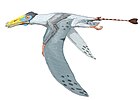

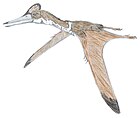


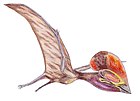


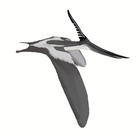

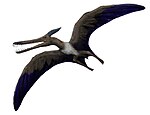
You must be logged in to post a comment.